Your tyres represent a major investment that you want to make last as long as possible. However, they are placed under considerable strain as a result of the work you do, the load, the type of ground or the environment which can rapidly have negative effects and lead to abnormal and premature wear. By taking 3 minutes regularly to carry out a visual inspection of the different parts of your tyres, it is easy to detect damages or signs of a pending problem that you can deal with, thus avoiding unexpected maintenance expenses, or worse still, premature tyre replacement.
In this article we look at 10 easy check-up points for a quick inspection to detect problems in advance.
Some of the irregularities you may encounter with your tractor tyres may also be a way of spotting more serious incidents, which are only visible at the level of the tyres to begin with, but which actually concern underlying mechanical faults.
By identifying them upstream, you can easily correct these mechanical faults and avoid a bigger problem later, irrespective of your tyres.
This very simple check-up routine can help you gain thousands of additional hours of use from your tyres or avoid breakdowns and, as such, unnecessary expenses.
Damage or wear to the lugs or tread
1. Worn lugs on the front tyres
You have noticed that the lugs on the front tyres are more worn, with traces of skidding on the surface of the lugs.
You should check the front axle, which may be engaged permanently. The front axle may be defective and 4WD is engaged permanently even when the indicator light is off.
To solve the problem, check whether the front axle is operating correctly.
2.Pronounced wear to the lug nose but only on one side
You have identified abnormal wear to the lug nose but only on one side of the lugs. This wear may be found on one of the front tyres, or both of the front tyres, with symetric wear on the inside or outside.
This type of wear is typical of a mechanical problem linked to wheel misalignment. The steering mechanism may be out of kilter or there may be too much play in the steering ball joints. However, most frequently the cause is a problem with parallelism, with the wheels not being parallel to the tractor: in the event of toe-in, the wear will be greater on the right side and in the event of toe-out, the wear will tend to be found on the left.
To solve this problem, the best solution is to check the entire front axle.
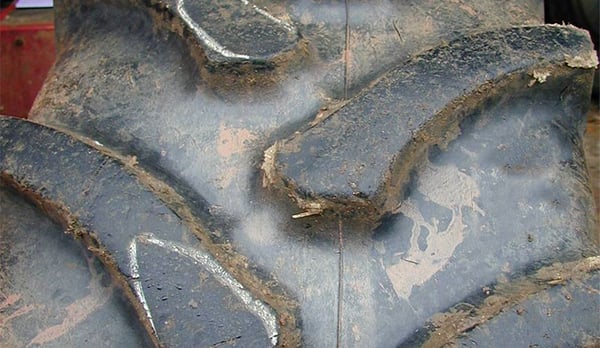 Lug wear on one side of the tyre only
Lug wear on one side of the tyre only
3. Continuous wear on one side of the front tyre
If the deterioration is concentrated on one side of the tyre, possibly with a right/left symmetry, there may be a mechanical fault with the front axle.
The wear may be linked to a problem with camber, which is to say the angle of inclination of the wheel, or a problem with parallelism (toe-in or toe-out). Whatever the cause of the wear, you must check the following points:
- The front differential,
- Wheel alignment (camber or parallelism),
- The play or wear in the steering ball jointsn.
When these mechanical problems have been sorted out, you may be able to swap your tyres over to extend their useful life. You can also continue to use them until they reach the level of wear recommended by the manufacturer. This will avoid you having to invest in a new set of tyres immediately.
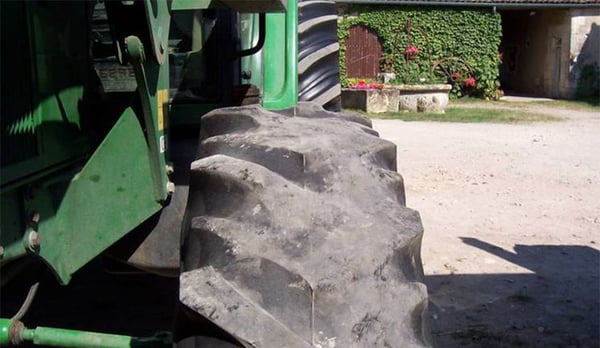 Wear on one side of the front tyres only
Wear on one side of the front tyres only
4. Pronounced wear at the centre of the tread
If you notice centralised wear only in the middle of the tread, on the lug nose and on all the tyre’s lugs, whether at the front or the rear or on all of the tyres.
It is highly probably that your tyres are overinflated, because when the pressure is too high, only the tip of the tread is in contact with the ground, which increases wear to the central part of the lugs but not to the sides.
Pressure must be reduced based on manufacturer recommendations.
If it’s the heavy loads which oblige you to increase inflation pressure, when it comes to changing your tyres, you should opt for high-tech IF tyres (they can carry 20% more load than standard tyres) or series 70 or 65 tyres with a higher volume of air which will have a greater load capacity.
5. Cuts or chipping on the lugs
There may be cuts or chipping on your agricultural tyre lugs, in particular if you work regularly on very abrasive ground with a high flint content or on stony land.
To reduce wear to your tyre you must limit the slip ratio to between 12% and 15% by adapting inflation pressure.
The tyre may continue to be used until it is fully worn, without any danger.
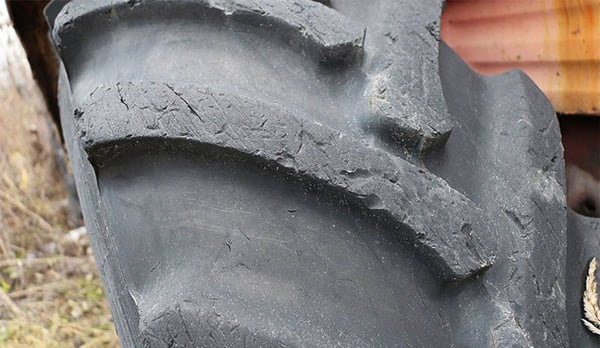 Cuts and chips on the lugs
Cuts and chips on the lugs
6. Scratches
When you work with a full load, your tyre may encounter different types of ground, hard terrain or stony land with the presence of sharp or abrasive objects.
There may be superficial cuts on your lugs and all over the tread, cuts which may be visible at the lug base, especially between the lugs. These particular cuts may be due to very hard stubble such as corn or sunflower.
If the tyre is not too worn, it can continue to be used, the scratching on the lugs or the tread at the lug base are not a threat, but your tyre will lose some of its power when working in the fields, because the lugs’ tractive power is diminished.
Even if the tyre seems to be fine, it’s definitely worthwhile checking for the presence of any deeper cut, which could cause an accident if you drive on the road at speed and with a high inflation pressure.
Pressure must be checked regularly and must always correspond to the load transported. When you replace your tyres, you can look for a more resistant tyre model which is better adapted to your work or your type of land.
7. Pleats at the lug base
Pleats at the lug base are often due to too much tractive effort, on hard ground, caused by excessive load transfers to the axle. It’s the excessive contortion of the lugs which leads to them tearing, and sometimes certain parts breaking off. This can cause heavy vibrations when driving.
It is possible to keep your tyre and continue to use it on condition that you check the load capacity and adapt pressure.
When you see signs of wear at the base of the lugs, make sure that you limit the loads you transport as well as your speed on the road.
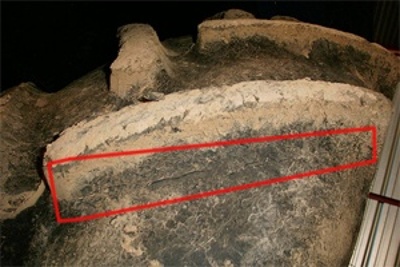 Pleats at the lug base
Pleats at the lug base
8. Irregular wear on the edge of the lug
Among the different points to check on your tyre, you may notice more pronounced wear at the front and back of the lugs, making the lugs more rounded. This may occur on all the tractor tyres.
This type of wear appears when you drive too often on the road with an underinflated tyre, or with underinflated tyres and an excess load. Reducing inflation pressure is a good way of avoiding compaction in the field, but when you drive on the road, it leads to abnormal wear to the lugs which are crushed by the load and chafe heavily against the abrasive asphalt.
To increase tyre life, you must reduce inflation pressure when you work in the fields and change to higher pressure on the road.
If you want to avoid these adjustments, when you buy new tyres opt for series 70 or 65 IF technology tyres with a higher volume of air, which allow you to carry more load without increasing pressure.
Anomalies or wear on the sidewall or edge of the rim
9. Fissure on the sidewall
While cuts to the lugs may be secondary and do not necessarily mean that your tyres have to be replaced, fissures on the sidewall are much more problematic. The sidewall is effectively a more fragile area and does not have the same level of reinforcement as the tread.
Fissures on the sidewall are often linked to driving with underinflated tyres or excess load.
Depending on the extent of the fissures, you can either continue driving or have the tyre replaced. If the fissures are tiny and more like pleats, you should inflate the tyres to the right pressure, having checked the load capacity. If the fissures are large, your safety cannot be guaranteed if you drive with a load.
When you go for a check-up with your tyre dealer, it would be wise to check that the internal structure of the tyre has not been affected by driving with underinflated tyres or too much load.
10. Signs of abrasion on the edge of the rim and/or fissure at the level of the bead turn-up
When you drive regularly on the road with a low inflation pressure or too much load, especially during harvesting, you must check for the appearance of signs of abrasion on the edge of the rim These signs of abrasion may be linked to rubbing between the base of the bead and the rim, in general due to overloading or driving with underinflated tyres.
Driving in these conditions can lead to the appearance of a fissure at the level of the bead turn-up, or a cut at the edge of the reinforced ply or ply fold over.
Just like the fissures on the sidewall, this type of wear is irreparable if the fissure is too deep. Your tyre is not fit for use and must be replaced.
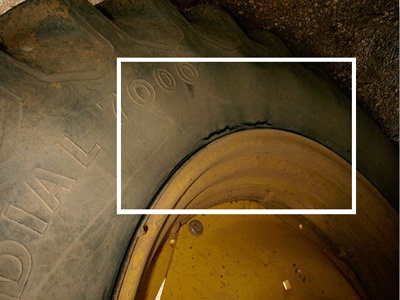 Fissure at the level of the bead turn-up
Fissure at the level of the bead turn-up
Conclusion
If you notice the early warning signs of a problem by recognising the onset of one of the 10 cases described above, don’t hesitate to contact your tyre dealer who will be able to confirm your diagnosis and sort out the problem, often very simply and much more economically than if you wait for the damage to worsen and have to replace the tyres.
To help you clearly define the causes of premature wear on your current tyres, we have developed a complete guide for you to download free of charge "How to detect abnormal wear in my tractor tyres"

Most people who read this article have also read some of the following articles:
This information is intended only to make you aware of the technical and functional aspects of agricultural tires and their use. It does not allow you to make a judgment or a definitive conclusion on a given problem. Only your agricultural tire expert is able to make a technical assessment and take a final decision, case by case.